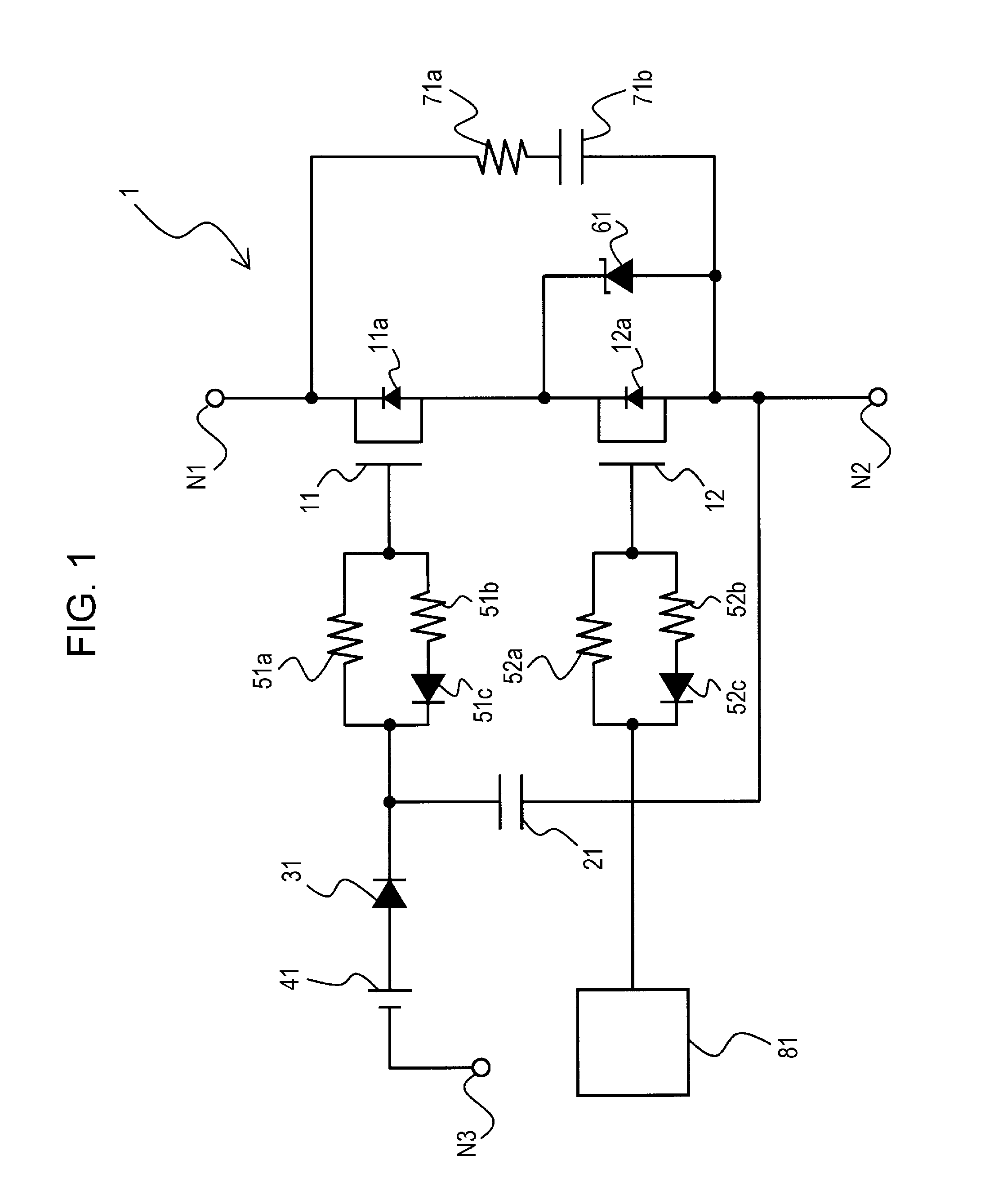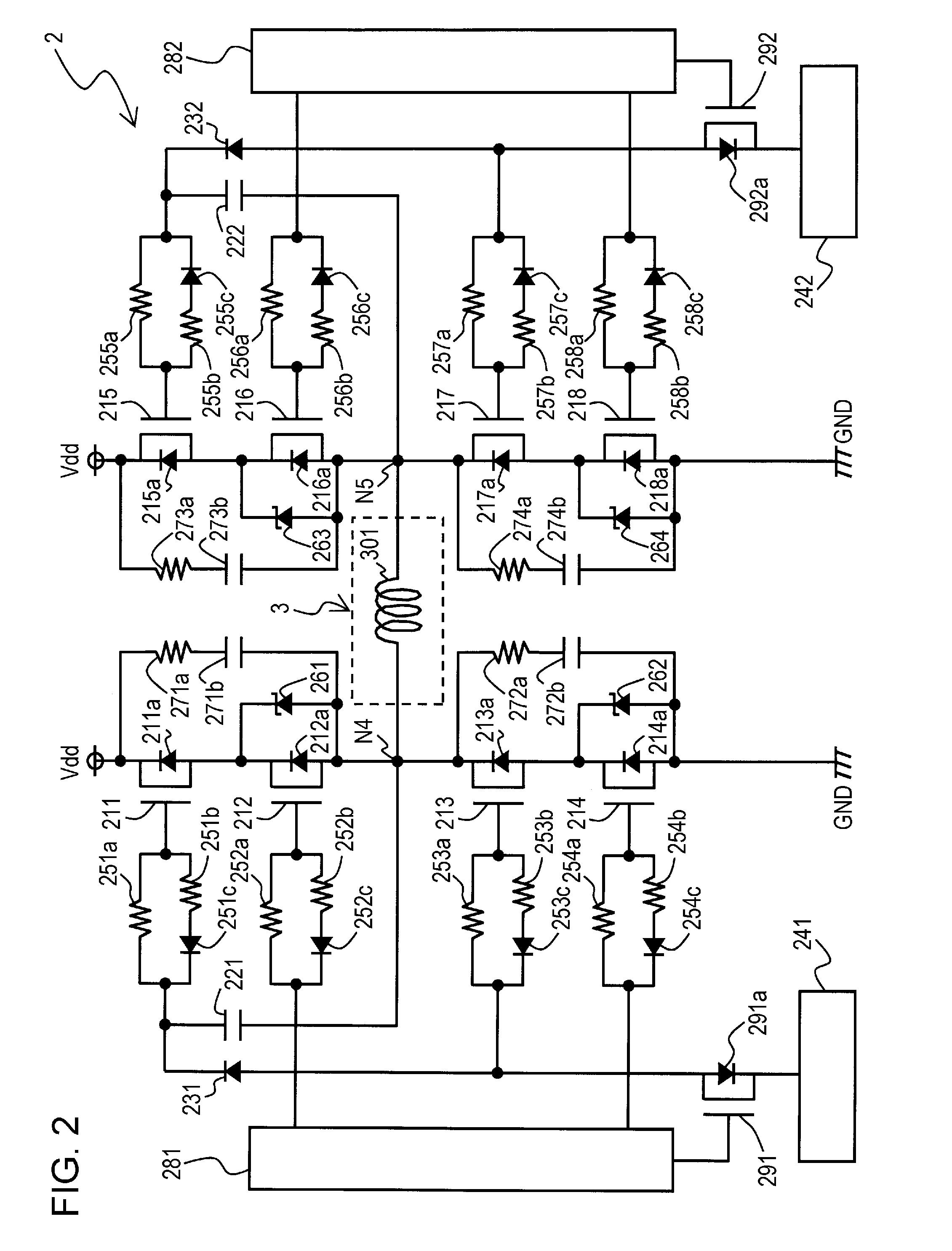Switching power supply device, and inverter, converter, and solar power controller including same
a technology of switching power supply and inverter, which is applied in the direction of pulse technique, process and machine control, instruments, etc., can solve the problems of large switching loss and high cos
- Summary
- Abstract
- Description
- Claims
- Application Information
AI Technical Summary
Benefits of technology
Problems solved by technology
Method used
Image
Examples
first preferred embodiment
[0020]As illustrated in FIG. 1, a switching power supply device 1 according to a first preferred embodiment of the present invention includes n-channel MOS transistors 11 and 12, capacitors 21 and 71b, diodes 31, 51c, and 52c, a gate power supply 41, resistors 51a, 51b, 52a, 52b, and 71a, a Zener diode 61, and a gate driver 81. The transistors 11 and 12 have built-in parasitic diodes 11a and 12a, respectively.
[0021]An anode of each of the parasitic diodes 11a and 12a is connected to a source (second electrode) of the corresponding transistor 11 (first transistor) and transistor 12 (second transistor), respectively, while a cathode of each of the parasitic diodes 11a and 12a is connected to a drain (first electrode) of the corresponding transistors 11 and 12, respectively.
[0022]The transistor 11 is a high withstand voltage transistor, having a source-drain withstand voltage of 600 V, for example. The transistor 12 is a low withstand voltage transistor, having a source-drain withstand...
second preferred embodiment
[0081]As illustrated in FIG. 2, an inverter 2 according to a second preferred embodiment of the present invention includes n-channel MOS transistors 211 to 218, 291, and 292, capacitors 221, 222, and 271b to 274b, diodes 231, 232, and 251c to 258c, gate power supplies 241 and 242, resistors 251a to 258a, 251b to 258b, and 271a to 274a, Zener diodes 261 to 264, and gate drivers 281 and 282. The transistors 211 to 218, 291, and 292 have built-in parasitic diodes 211a to 218a, 291a, and 292a, respectively.
[0082]An anode of each of the parasitic diodes 211a to 218a, 291a, and 292a is connected to a source of each of the corresponding transistors 211 to 218, 291, and 292, respectively, while a cathode of each of a parasitic diodes 211a to 218a, 291a, and 292a is connected to a drain of each of the corresponding transistors 211 to 218, 291, and 292, respectively.
[0083]Each of the transistors 211, 213, 215, and 217 is a high withstand voltage transistor, having a source-drain withstand vol...
third preferred embodiment
[0122]FIG. 5 illustrates a step-up chopper 4 according to a third preferred embodiment of the present invention. The step-up chopper 4 includes a circuit that is similar to the inverter 2. The step-up chopper 4 and the inverter 2 are different only in that the upper-left and lower-left arms and the upper-right and lower-right arms are joined by a coil 401 which is part of the step-up chopper 4, the drain of the transistor 215 of the upper-right arm is connected to an input terminal Vin, and the drain of the transistor 211 of the upper-left arm is connected to an output terminal Vout. Note that description will be reduced or omitted for elements having the same reference numerals as the inverter 2.
[0123]Operation of the step-up chopper will be described. When the transistors 214 and 216 are turned on, current flows from the input terminal Vin, through the transistors 215 and 216, the coil 401, and the transistors 213 and 214, to the ground voltage GND line, and electromagnetic energy...
PUM
 Login to View More
Login to View More Abstract
Description
Claims
Application Information
 Login to View More
Login to View More - R&D
- Intellectual Property
- Life Sciences
- Materials
- Tech Scout
- Unparalleled Data Quality
- Higher Quality Content
- 60% Fewer Hallucinations
Browse by: Latest US Patents, China's latest patents, Technical Efficacy Thesaurus, Application Domain, Technology Topic, Popular Technical Reports.
© 2025 PatSnap. All rights reserved.Legal|Privacy policy|Modern Slavery Act Transparency Statement|Sitemap|About US| Contact US: help@patsnap.com



